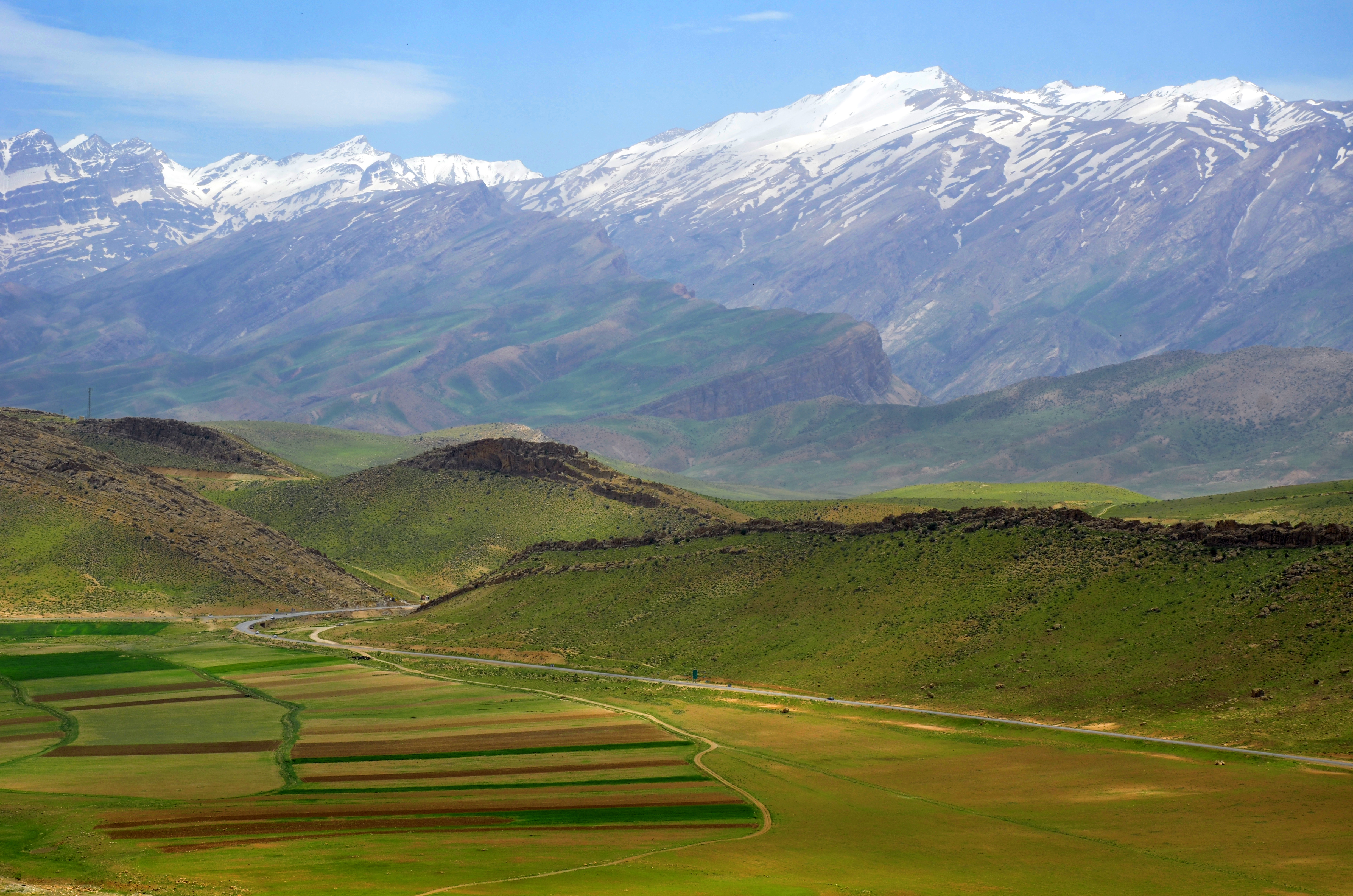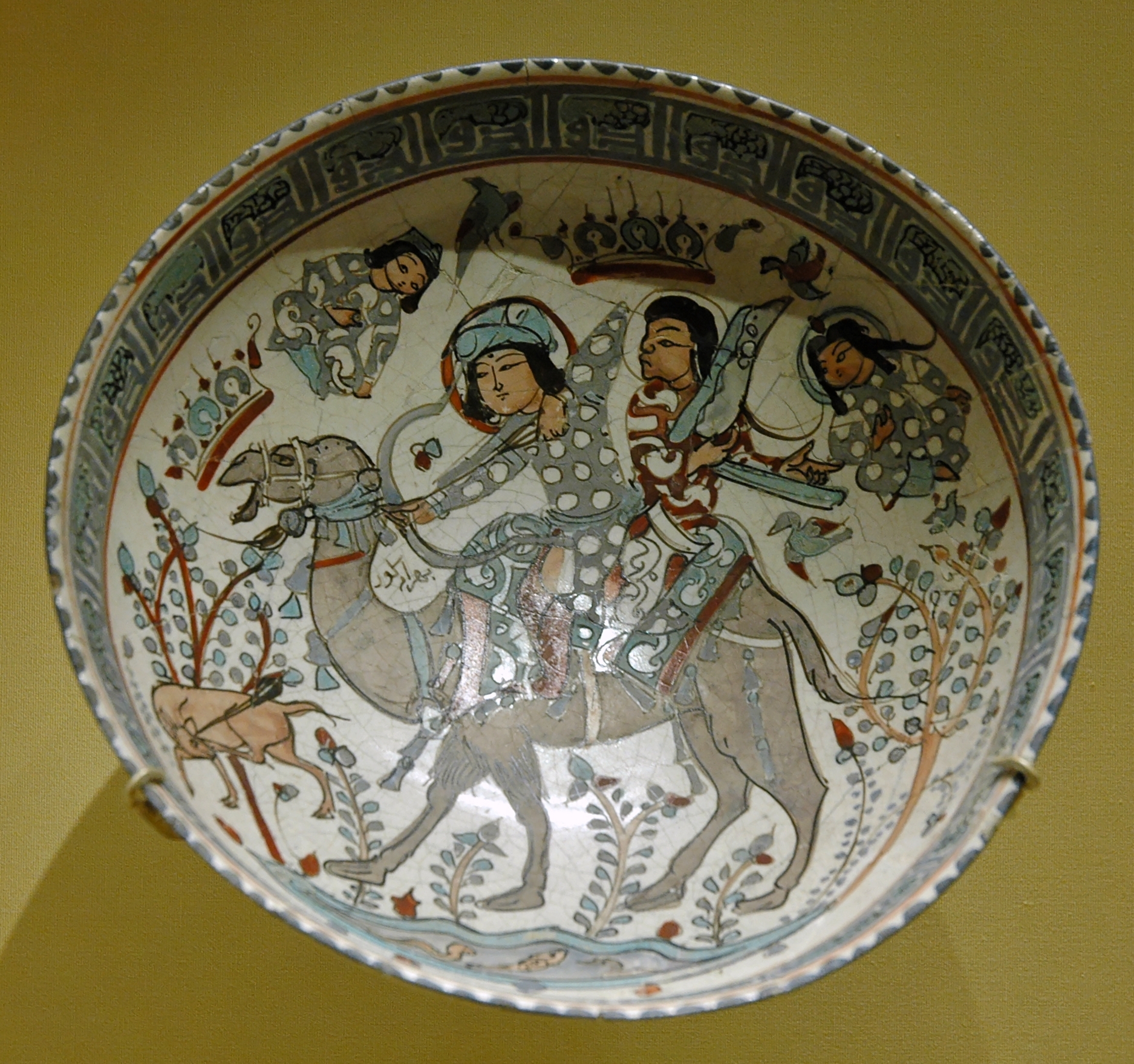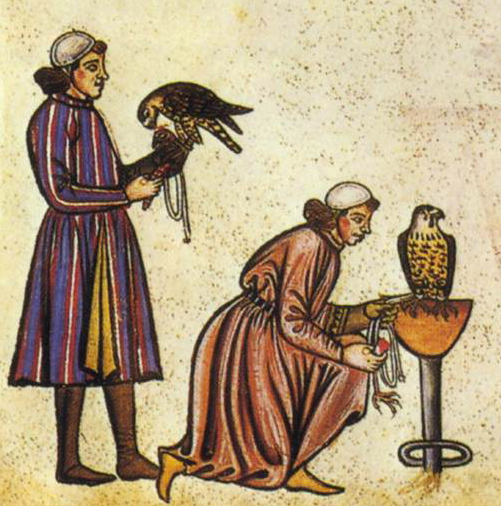|
Bushel With Ibex Motifs
The bushel with ibex motifs, also known as the beaker with ibex motifs, is a prehistoric pottery artifact originating from Susa, an ancient city in the Near East located in modern-day Iran. This piece of art is believed to have been created during the Susa I period, between 4200 and 3500 BCE. The bushel is a large vessel, measuring 28.9 x 16.4 cm, and was used as a funerary item among the first inhabitants of Susa. The bushel is considered an example of animal style, a decorative approach in art that emphasizes animal motifs. The bushel features various animal motifs including long-necked birds in the upper register, thought to be a kind of wading water bird commonly seen in the region's plains during winter. The next register showcases reclining dogs, which are believed to be saluki or greyhound type hunting dogs typical of the area. The most notable feature of the bushel is the ibex, or mountain goat, motifs, located below the dogs. The ibex, a native of the Zagros Mountain ... [...More Info...] [...Related Items...] OR: [Wikipedia] [Google] [Baidu] |
Terracotta
Terracotta, also known as terra cotta or terra-cotta (; ; ), is a clay-based non-vitreous ceramic OED, "Terracotta""Terracotta" MFA Boston, "Cameo" database fired at relatively low temperatures. It is therefore a term used for earthenware objects of certain types, as set out below. Usage and definitions of the term vary, such as: *In art, pottery, applied art, and craft, "terracotta" is a term often used for red-coloured earthenware sculptures or functional articles such as flower pots, water and waste water pipes, and tableware. *In archaeology and art history, "terracotta" is often used to describe objects such as figurines and loom weights not made on a potter's wheel, with vessels and other objects made on a wheel from the same material referred to as earthenware; the choice of term depends on the type of object rather than the material or shaping technique. *Terracotta is also used to refer to the natural brownish-orange color of most terracotta. *In architecture, ... [...More Info...] [...Related Items...] OR: [Wikipedia] [Google] [Baidu] |
Zagros Mountains
The Zagros Mountains are a mountain range in Iran, northern Iraq, and southeastern Turkey. The mountain range has a total length of . The Zagros range begins in northwestern Iran and roughly follows Iran's western border while covering much of southeastern Turkey and northeastern Iraq. From this border region, the range continues southeast to the waters of the Persian Gulf. It spans the southern parts of the Armenian highlands, and the whole length of the western and southwestern Iranian plateau, ending at the Strait of Hormuz. The highest point is Mount Dena, at . Geology The Zagros fold and thrust belt was mainly formed by the collision of two tectonic plates, the Eurasian Plate and the Arabian Plate. This collision mainly happened during the Miocene (about 25–5 mya or million years ago) and folded the entirety of the rocks that had been deposited from the Paleozoic (541–242 mya) to the Cenozoic (66 mya – present) in the passive continental margin on the Ar ... [...More Info...] [...Related Items...] OR: [Wikipedia] [Google] [Baidu] |
Near Eastern And Middle Eastern Antiquities In The Louvre
NEAR or Near may refer to: People * Thomas J. Near, US evolutionary ichthyologist * Near, a developer who created the higan emulator Science, mathematics, technology, biology, and medicine * National Emergency Alarm Repeater (NEAR), a former alarm device to warn civilians of a foreign nuclear attack on the United States * National Emergency Airway Registry (NEAR), a patient registry for intubations in the United States * Nicking enzyme amplification reaction (NEAR), a method of DNA amplification * NEAR Protocol, a layer-1 blockchain * NEAR Shoemaker, a spacecraft that studied the near-Earth asteroid Eros * Nearness or proximity space *"Near", a city browser by NearGlobal * Near space, the upper atmosphere below outer space Television, film, music, and books * Near (Death Note), ''Nate River'', a character Other uses * Near v. Minnesota, a U.S. press freedom Supreme Court decision * New England Auto Racers Hall of Fame The New England Auto Racers Hall of Fame is a hall ... [...More Info...] [...Related Items...] OR: [Wikipedia] [Google] [Baidu] |
Iranian Pottery
Persian pottery or Iranian pottery is the pottery made by the artists of Persia, Persia (Iran) and its history goes back to early Neolithic Age (7th millennium BCE). Agriculture gave rise to the baking of clay, and the making of utensils by the people of Iran. Through the centuries, Persian potters have responded to the demands and changes brought by political turmoil by adopting and refining newly introduced forms and blending them into their own culture. This innovative attitude has survived through time and influenced many other cultures around the world. There were two types of earthenware that were prevalent in Iran around 4,000 BC: red and black ceramics that were simplistic in their decorative style. As the art expanded, earthenware incorporated geometric designs which resulted in a more developed decorative style. This increasingly complex style was accompanied by the creation of a wider variety of the kinds of pottery that were made. In the prehistoric period, the pr ... [...More Info...] [...Related Items...] OR: [Wikipedia] [Google] [Baidu] |
Goats In Art
The goat or domestic goat (''Capra hircus'') is a species of goat-antelope that is mostly kept as livestock. It was domesticated from the wild goat (''C. aegagrus'') of Southwest Asia and Eastern Europe. The goat is a member of the family Bovidae, meaning it is closely related to the sheep. It was one of the first animals to be domesticated, in Iran around 10,000 years ago. Goats have been used for milk, meat, wool, and skins across much of the world. Milk from goats is often turned into cheese. In 2022, there were more than 1.1 billion goats living in the world, of which 150 million were in India. Goats feature in mythology, folklore, and religion in many parts of the world, including in the classical myth of Amalthea, in the goats that pulled the chariot of the Norse god Thor, in the Scandinavian Yule goat, and in Hinduism's goat-headed Daksha. In Christianity and Satanism, the devil is sometimes depicted as a goat. Etymology The Modern English word ''goat'' c ... [...More Info...] [...Related Items...] OR: [Wikipedia] [Google] [Baidu] |
Dogs In Art
Cultural depictions of dogs in art has become more elaborate as individual breeds evolved and the relationships between human and canine developed. Hunting scenes were popular in the Middle Ages and the Renaissance. Dogs were depicted to symbolize Guide, guidance, protection, loyalty, fidelity, faithfulness, alertness, and love. As dogs became more domesticated, they were shown as Pet, companion animals, often painted sitting on a lady's lap. Throughout art history, mainly in Western art, there is an overwhelming presence of dogs as status symbols and pets in painting. The dogs were brought to houses and were allowed to live in the house. They were cherished as part of the family, and were regarded highly by the upper classes, who used them for hunting and could afford to feed them. Hunting dogs were generally connected to the aristocracy. Only the nobility were allowed to keep hunting dogs, and this would signal status. Dogs are unusual in Christian religious art, but the New T ... [...More Info...] [...Related Items...] OR: [Wikipedia] [Google] [Baidu] |
Birds In Art
Human uses of birds have, for thousands of years, included both economic uses such as food, and symbolic uses such as art, music, and religion. In terms of economic uses, birds have been hunted for food since Palaeolithic times. They have been captured and bred as poultry to provide meat and eggs since at least the time of ancient Egypt. Some species have been used, too, to help locate or to catch food, as with cormorant fishing and the use of honeyguides. Feathers have long been used for bedding, as well as for quill pens and for fletching arrows. Today, many species face habitat loss and other threats caused by humans; bird conservation groups work to protect birds and to influence governments to do so. Birds have appeared in the mythologies and religions of many cultures since ancient Sumer. For example, the dove was the symbol of the ancient Mesopotamian goddess Inanna, the Canaanite mother goddess Asherah, and the Greek goddess Aphrodite. Athena, the Greek goddess of wisd ... [...More Info...] [...Related Items...] OR: [Wikipedia] [Google] [Baidu] |
Archaeological Discoveries In Iran
Archaeology or archeology is the study of human activity through the recovery and analysis of material culture. The archaeological record consists of Artifact (archaeology), artifacts, architecture, biofact (archaeology), biofacts or ecofacts, archaeological site, sites, and cultural landscapes. Archaeology can be considered both a social science and a branch of the humanities. It is usually considered an independent academic discipline, but may also be classified as part of anthropology (in North America – the four-field approach), history or geography. The discipline involves Survey (archaeology), surveying, Archaeological excavation, excavation, and eventually Post excavation, analysis of data collected, to learn more about the past. In broad scope, archaeology relies on cross-disciplinary research. Archaeologists study human prehistory and history, from the development of the first stone tools at Lomekwi in East Africa 3.3 million years ago up until recent decades. A ... [...More Info...] [...Related Items...] OR: [Wikipedia] [Google] [Baidu] |
1900s In Iran
Nineteen or 19 may refer to: * 19 (number) * One of the years 19 BC, AD 19, 1919, 2019 Films * 19 (film), ''19'' (film), a 2001 Japanese film * Nineteen (1987 film), ''Nineteen'' (1987 film), a 1987 science fiction film * ''19-Nineteen'', a 2009 South Korean film * ''Diciannove'', a 2024 Italian drama film informally referred to as "Nineteen" in some sources Science * Potassium, an alkali metal * 19 Fortuna, an asteroid Music * 19 (band), a Japanese pop music duo Albums * 19 (Adele album), ''19'' (Adele album), 2008 * ''19'', a 2003 album by Alsou * ''19'', a 2006 album by Evan Yo * ''19'', a 2018 album by MHD (rapper), MHD * ''19'', one half of the double album ''63/19'' by Kool A.D. * ''Number Nineteen'', a 1971 album by American jazz pianist Mal Waldron * XIX (EP), ''XIX'' (EP), a 2019 EP by 1the9 Songs * 19 (song), "19" (song), a 1985 song by British musician Paul Hardcastle * "Stone in Focus", officially "#19", a composition by Aphex Twin * "Nineteen", a song fr ... [...More Info...] [...Related Items...] OR: [Wikipedia] [Google] [Baidu] |
1900s Archaeological Discoveries
Nineteen or 19 may refer to: * 19 (number) * One of the years 19 BC, AD 19, 1919, 2019 Films * ''19'' (film), a 2001 Japanese film * ''Nineteen'' (1987 film), a 1987 science fiction film * '' 19-Nineteen'', a 2009 South Korean film * ''Diciannove'', a 2024 Italian drama film informally referred to as "Nineteen" in some sources Science * Potassium, an alkali metal * 19 Fortuna, an asteroid Music * 19 (band), a Japanese pop music duo Albums * ''19'' (Adele album), 2008 * ''19'', a 2003 album by Alsou * ''19'', a 2006 album by Evan Yo * ''19'', a 2018 album by MHD * ''19'', one half of the double album ''63/19'' by Kool A.D. * ''Number Nineteen'', a 1971 album by American jazz pianist Mal Waldron * ''XIX'' (EP), a 2019 EP by 1the9 Songs * "19" (song), a 1985 song by British musician Paul Hardcastle * "Stone in Focus", officially "#19", a composition by Aphex Twin * "Nineteen", a song from the 1992 album ''Refugee'' by Bad4Good * "Nineteen", a song from the 2001 a ... [...More Info...] [...Related Items...] OR: [Wikipedia] [Google] [Baidu] |






